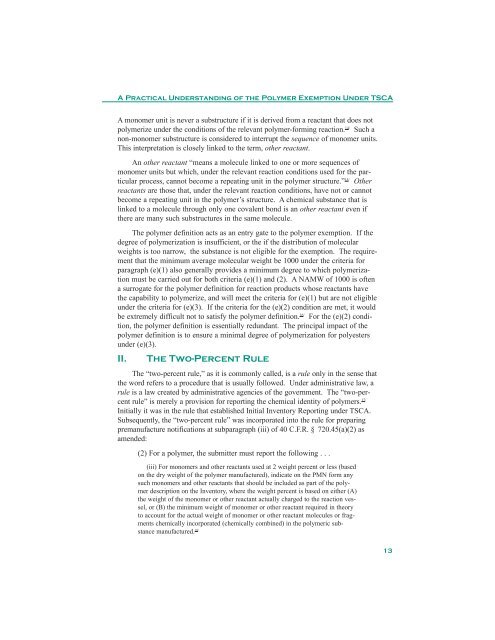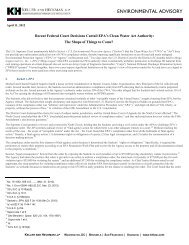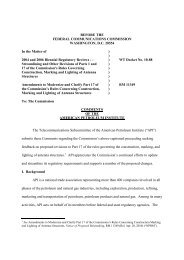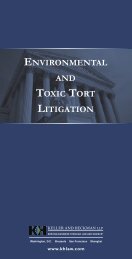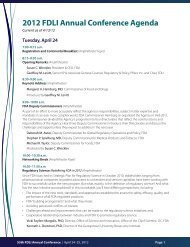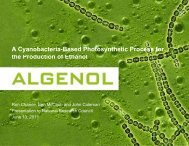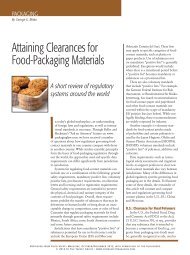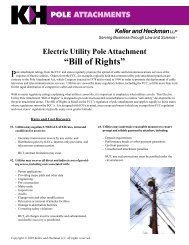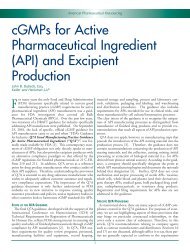A Practical Understanding of the Polymer ... - Keller Heckman
A Practical Understanding of the Polymer ... - Keller Heckman
A Practical Understanding of the Polymer ... - Keller Heckman
You also want an ePaper? Increase the reach of your titles
YUMPU automatically turns print PDFs into web optimized ePapers that Google loves.
A <strong>Practical</strong> <strong>Understanding</strong> <strong>of</strong> <strong>the</strong> <strong>Polymer</strong> Exemption Under TSCA<br />
A monomer unit is never a substructure if it is derived from a reactant that does not<br />
polymerize under <strong>the</strong> conditions <strong>of</strong> <strong>the</strong> relevant polymer-forming reaction. 14/ Such a<br />
non-monomer substructure is considered to interrupt <strong>the</strong> sequence <strong>of</strong> monomer units.<br />
This interpretation is closely linked to <strong>the</strong> term, o<strong>the</strong>r reactant.<br />
An o<strong>the</strong>r reactant “means a molecule linked to one or more sequences <strong>of</strong><br />
monomer units but which, under <strong>the</strong> relevant reaction conditions used for <strong>the</strong> particular<br />
process, cannot become a repeating unit in <strong>the</strong> polymer structure.” 15/ O<strong>the</strong>r<br />
reactants are those that, under <strong>the</strong> relevant reaction conditions, have not or cannot<br />
become a repeating unit in <strong>the</strong> polymer’s structure. A chemical substance that is<br />
linked to a molecule through only one covalent bond is an o<strong>the</strong>r reactant even if<br />
<strong>the</strong>re are many such substructures in <strong>the</strong> same molecule.<br />
The polymer definition acts as an entry gate to <strong>the</strong> polymer exemption. If <strong>the</strong><br />
degree <strong>of</strong> polymerization is insufficient, or <strong>the</strong> if <strong>the</strong> distribution <strong>of</strong> molecular<br />
weights is too narrow, <strong>the</strong> substance is not eligible for <strong>the</strong> exemption. The requirement<br />
that <strong>the</strong> minimum average molecular weight be 1000 under <strong>the</strong> criteria for<br />
paragraph (e)(1) also generally provides a minimum degree to which polymerization<br />
must be carried out for both criteria (e)(1) and (2). A NAMW <strong>of</strong> 1000 is <strong>of</strong>ten<br />
a surrogate for <strong>the</strong> polymer definition for reaction products whose reactants have<br />
<strong>the</strong> capability to polymerize, and will meet <strong>the</strong> criteria for (e)(1) but are not eligible<br />
under <strong>the</strong> criteria for (e)(3). If <strong>the</strong> criteria for <strong>the</strong> (e)(2) condition are met, it would<br />
be extremely difficult not to satisfy <strong>the</strong> polymer definition. 16/ For <strong>the</strong> (e)(2) condition,<br />
<strong>the</strong> polymer definition is essentially redundant. The principal impact <strong>of</strong> <strong>the</strong><br />
polymer definition is to ensure a minimal degree <strong>of</strong> polymerization for polyesters<br />
under (e)(3).<br />
II.<br />
The Two-Percent Rule<br />
The “two-percent rule,” as it is commonly called, is a rule only in <strong>the</strong> sense that<br />
<strong>the</strong> word refers to a procedure that is usually followed. Under administrative law, a<br />
rule is a law created by administrative agencies <strong>of</strong> <strong>the</strong> government. The “two-percent<br />
rule” is merely a provision for reporting <strong>the</strong> chemical identity <strong>of</strong> polymers. 17/<br />
Initially it was in <strong>the</strong> rule that established Initial Inventory Reporting under TSCA.<br />
Subsequently, <strong>the</strong> “two-percent rule” was incorporated into <strong>the</strong> rule for preparing<br />
premanufacture notifications at subparagraph (iii) <strong>of</strong> 40 C.F.R. § 720.45(a)(2) as<br />
amended:<br />
(2) For a polymer, <strong>the</strong> submitter must report <strong>the</strong> following . . .<br />
(iii) For monomers and o<strong>the</strong>r reactants used at 2 weight percent or less (based<br />
on <strong>the</strong> dry weight <strong>of</strong> <strong>the</strong> polymer manufactured), indicate on <strong>the</strong> PMN form any<br />
such monomers and o<strong>the</strong>r reactants that should be included as part <strong>of</strong> <strong>the</strong> polymer<br />
description on <strong>the</strong> Inventory, where <strong>the</strong> weight percent is based on ei<strong>the</strong>r (A)<br />
<strong>the</strong> weight <strong>of</strong> <strong>the</strong> monomer or o<strong>the</strong>r reactant actually charged to <strong>the</strong> reaction vessel,<br />
or (B) <strong>the</strong> minimum weight <strong>of</strong> monomer or o<strong>the</strong>r reactant required in <strong>the</strong>ory<br />
to account for <strong>the</strong> actual weight <strong>of</strong> monomer or o<strong>the</strong>r reactant molecules or fragments<br />
chemically incorporated (chemically combined) in <strong>the</strong> polymeric substance<br />
manufactured. 18/<br />
13


